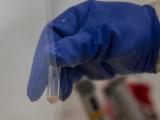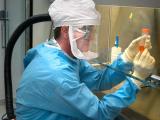Nov 2, 2001 (CIDRAP News) The Food and Drug Administration (FDA) published a notice in the Federal Register this week to make clear that doxycycline and penicillin G procaine, along with ciprofloxacin, already are approved for use as postexposure prophylaxis following inhalational exposure to anthrax. The notice also details postexposure dosing regimens for these medications.
Current labeling for these drugs says that they are indicated for anthrax, but it does not specify that they are effective for treating all forms of anthrax, including cutaneous, inhalational, and gastrointestinal anthrax, and for use following exposure to inhalational anthrax, according to the Oct 30 FDA notice. The notice encourages drug manufacturers to revise the labeling to include these details.
"We have determined that the language in the labeling of drug products containing doxycycline, doxycycline calcium, doxycycline hyclate, and penicillin G procaine is intended to, and does, cover all forms of anthrax, including inhalational anthrax (post-exposure)," the FDA notice states.
The agency says doxycycline can be used for anthrax in both adults and children. A talk paper on the FDA Web site states, "Doxycycline and other members of the tetracycline class of antibiotics are not generally indicated for the treatment of any patients under the age of 8 years because of their negative effects on teeth and bone development. However, FDA believes the benefits of doxycycline for the treatment of inhalational anthrax (post-exposure) outweigh these risks." The Federal Register notice says the effects on teeth and bones are apparently reversible.
The recommended doxycycline regimen for adults following inhalational exposure to Bacillus anthracis is 100 mg orally twice a day for 60 days, the Federal Register notice says. The corresponding regimen for children weighing less than 100 lb is 1 mg/lb (2.2 mg/kg) twice daily for 60 days.
For penicillin G procaine, the FDA recommends a postexposure regimen of 1,200,000 U every 12 hours for adults with inhalational exposure. The recommendation for children is 25,000 U/kg (maximum 1,200,000 U) every 12 hours. The agency suggests that labeling for this indication should include a warning that the use of penicillin for more than 2 weeks may increase the risk of neutropenia and serum-sickness-like reactions.
The dosage recommendations are based on the FDA's review of the scientific literature and the same rhesus-monkey study used to support the agency's approval of ciprofloxacin as postexposure prophylaxis for inhalational anthrax, the notice says. That study included doxycycline and penicillin G procaine arms, each of which showed a survival benefit over placebo.
Editor's note: Given this notice and other federal reports, three antibiotics (ciprofloxacin, doxycycline, and penicillin G procaine) are approved for use following exposure to inhalational anthrax. However, readers should note that this notice does not state that these postexposure prophylaxis recommendations are intended specifically for the current strain of B anthracis that is circulating on the East Coast. Preliminary data indicate that B anthracis isolates from Florida, New York, and New Jersey have constitutive and inducible beta-lactamases that may promote penicillin resistance (CDC:MMWR 2001;50[42]:909-19). Therefore, ciprofloxacin and doxycycline are the recommended agents for postexposure prophylaxis during the current outbreak, unless further information becomes available.
See also:
Federal Register notice, "Prescripton drug products; doxycycline and penicillin G procaine administration for inhalational anthrax"
http://www.fda.gov/ohrms/dockets/98fr/cd01156.pdf




















